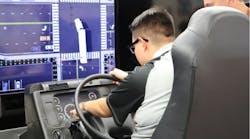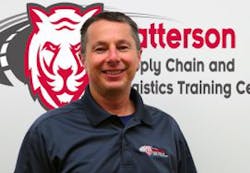Dave Dein, a teacher at Patterson High School in California, was unsure what to expect when the father of a student came to speak him two months ago with tears in his eyes.
“Before my son took your class, he never felt successful,” Dein recalled the father saying.
That student is one of 16 seniors enrolled in what might be the first truck-driving program for high school students in the United States.
Dein, a former truck driver, oversees the program with the support of superintendent Dr. Philip Alfano, who previously created a supply chain and logistics management program at the school.
After witnessing the success of that program, Dein approached Alfano about developing a driver course. He spent a year setting up an adult education class, and worked with fleets and industry groups to fine tune the curriculum.
The school leaned on guidance counselors to find the right kids for the program. Ones that “needed to find something they could connect with,” Dein said.
The students remind Dein of himself at that age. He admitted to not being the most “academically strong student,” and it wasn’t until he went to truck driving school that he “realized I was not stupid.”
Dein’s trucking journey began in 1988 as a way to support himself through college. After earning a bachelor’s degree in business administration, he was hired by a manufacturing company as a driver/manager.
He logged 700,000 accident- and ticket-free miles before becoming an elementary school teacher. Dein also founded a tuition-free, non-profit truck driving school called Faith Logistics, training rehabilitated prisoners how to drive trucks and providing them job placement assistance.
His focus today is on the high school students. They are receiving 180 hours of classroom instruction and 20 hours on an ATS truck simulator.
After graduation they can obtain free behind-the-wheel training with Morning Star Trucking or enroll in the adult education program. Morning Star, one of the fleets Dein once drove for, is offering temporary employment transporting tomatoes during the summer, where graduates can earn up to $12,000.
Other partners are Penske Logistics and Worklete, which teaches ergonomics and injury-prevention skills.
Dein said the high school course includes a daily discussion of trucking industry issues, including the debate over whether people under 21 should be allowed to drive commercial vehicles across state lines. That won’t hold these students back, who have the chance to drive within the border of one of the largest states in the nation.
Dein said he has witnessed the growth and maturity of the students, particularly in their aware of driver distractions and safety.
He noted some students struggle a bit with the pre-trip inspection because they do not have much prior knowledge when in comes to identifying vehicle parts. But incorporating more technology into the curriculum tends to speed the learning process.
Looking ahead, Dein said he hopes to double the number of students next year, and that the first female students will sign up.
That may become easier as the program attracts more attention. Dein said a Fortune 500 company has reached out to set up an apprenticeship program that could help students earn up to $70,000 annually.





